#Friedrich Bruckmann
Explore tagged Tumblr posts
Video
youtube
les damnés : martin von essenbeck x friedrich bruckmann
music : queer - garbage
#les damnés#les damnes#the damned#Martin von Essenbeck#Friedrich Bruckmann#Ivo Van Hove#comédie française#comedie francaise#theater#théâtre#french theater#jan verweysfeld#luchino visconti#helmut berger#amv#music video#garbage#queer#mlm#van hove#Festival d'Avignon#salle richelieu#otp#gay#lgbt#shipping#von essenbeck#guillaume gallienne#christophe montenez
6 notes
·
View notes
Text
“Anna, Thy Charms” - Robert Burns (1759-1796)
Anna, thy charms my bosom fire, And waste my soul with care; But ah! how bootless to admire, When fated to despair! Yet in thy presence, lovely Fair, To hope may be forgiven; For sure 'twere impious to despair So much in sight of heaven.
Happy Robert Burns’s Birthday!

Portrait of Robert Burns, Friedrich Bruckmann (1814-1898)
#poem#poetry#Robert Burns#Burns Night#love poem#love poetry#lyric poem#lyric poetry#ballad stanza#British literature#Scottish literature#Scottish poetry#Scotland#Friedrich Bruckmann
32 notes
·
View notes
Photo

Melanchthon [Philipp Melanchthon (born Philipp Schwartzerd) (1497-1560)] from a Painting by A. Noack, Friedrich Bruckmann, 1866-1899, Harvard Art Museums: Photographs
Harvard Art Museums/Fogg Museum, Transfer from the Carpenter Center for the Visual Arts Size: mount: 17.1 x 11.3 cm (6 3/4 x 4 7/16 in.) Medium: Albumen silver print on card.
https://www.harvardartmuseums.org/collections/object/154961
2 notes
·
View notes
Text
« Les Damnés » by Luchino Visconti, Nicola Badalucco and Enrico Medioli : Directed by Ivo van Hove (Comédie-Française Salle Richelieu, September 24 2016 to January 13 2017)
The play of the night was first created for the Cours d’Honneur at the Festival d’Avignon last July, marking the return of the Comédie-Française to the notorious festival after 23 years of absence. For the occasion, Éric Ruf, the current general administrator of the company invited Belgian theatre director Ivo van Hove, known for his direction of Toneelgroep Amsterdam in Netherland. The play is a variation of Luchino Visconti’s film The Damned(1969), but the creators repeatedly reminds us that it is not an adaptation of the film itself, but a work which shares its scenario, authored by Visconti himself, Enrico Medioli and Nicola Badalucco.
The scenario portrays the damnation of the von Essenbeck family, a German bourgeois running a large steel company, under the pressure of the rising Nazi reign and by the collision of the darkest desires and secrets within the family, of greed, of lust, and of hatred.
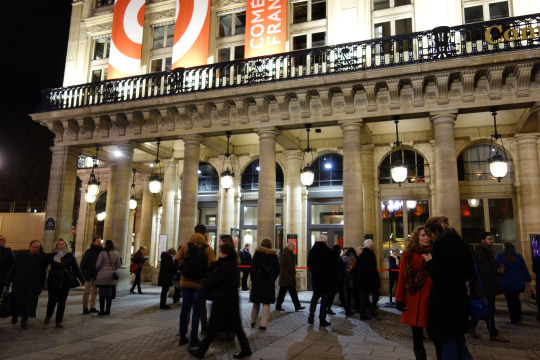
Having received great attention and later acclamation, the biggest focus for its reprise in Paris was how the play, originally created for an open-air stage at Palais de Pope translated itself for the classical proscenium arch stage of Salle Richelieu.

Photo by Christophe Raynaud de Lage(at Festival d’Avignon, Cour d’honneur of Palais de Pope)
As seen above, the original stage consisted of an orange acting space at stage centre, with 6 coffins lined to stage left, and a dressing and makeup space to the stage right. This basic arrangement was not altered, but at Salle Richelieu, the acting taking place off of the orange acting space was, although greatly depending on seat positions, visually compromised. Below is an example of the limited view from an attic seat.
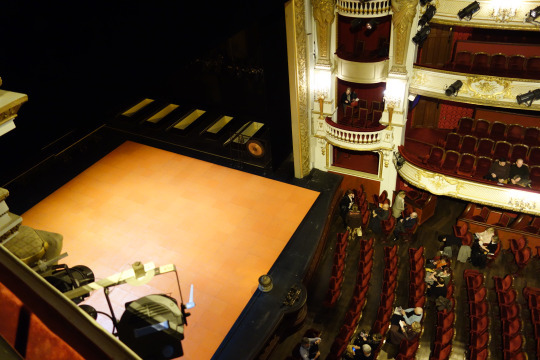
You will also be able to get an image of the view from the ground seats from this video by Entrée libre:
youtube
Not having seen the original production at Avignon, I found the version Richelieu to be deeply satisfactory. True, the architecture of the theatre resulted in optical limitations in numerous scenes, and different ambiances were born for these tableaus. Still, the employment of live video-recording and projection on scene has for this play worked to tolerate such defaults, if not allowing the audience to share the feeling of suffocation looming over the Essenbeck mansion and its many closed doors.
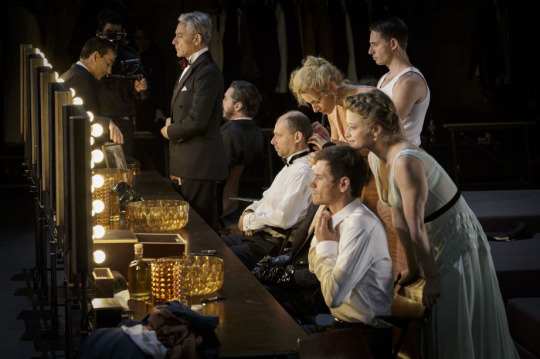
Photo by Christophe Raynaud de Lage (Festival d’Avignon)
And vice versa, because of this element of secrecy and enigma that was to be revealed through the lenses and magnified by the projection on screen, the introduction of live-recording on stage seemed justly incorporated into the mise en scène. The camera and projection allowed a new dimension to the dramatic techniques, by showing historical references and captions, providing close-ups of the actors’ facial and physical expressions, translating the footage to monochrome, capturing and showing symbolic scenes and objects as scenery, and even providing simultaneous composite images which in turn contrast to the actual performance on stage.
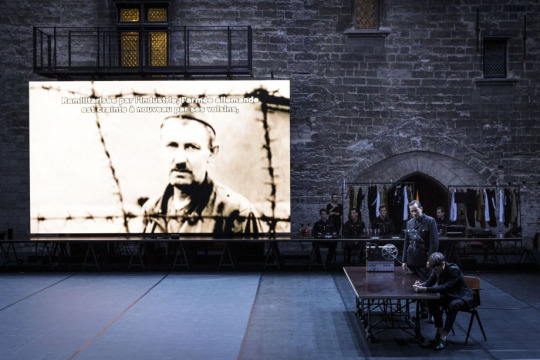
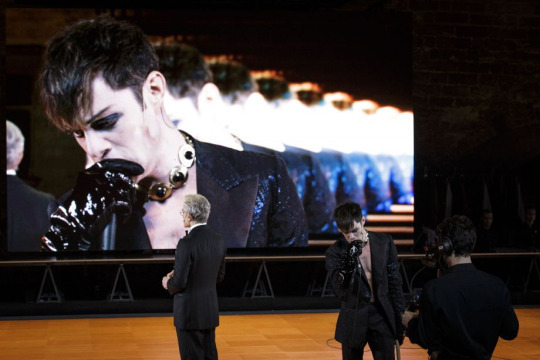
Photos by Christophe Raynaud de Lage (Festival d’Avignon)
What surprises me about Ivo van Hove’s direction was the utter delicateness with which he unites the extremely harsh and violent elements of this mise en scène. There was rawness to the textures he chose to highlight: silver, ashes, blood, tar, and feather. Nudity, violence, incest, pedophile and repeated imagery of death was put on stage. The sound effects too were given raw edges by the employment of Chinese gongs and the high-pitched whistling sounds, the former announcing another death and the latter symbolising the family’s shared asset/curse, the steel plant. Yet the Belgian director managed to orchestrate these into a wondrously sophisticated masquerade of human desires and their failures, so much so that the spectators wince at the sight of blood splashed on stage in the admirable scene in the later half of the performance portraying the « Night of the long knives », with composite image of pre-recorded and live-recorded videos.

Photo by Christophe Raynaud de Lage
GÉNÉRIQUE :
Les Damnés d’après le scénario de Luchino Visconti, Nicola Badalucco et Enrico Medioli
Mise en scène Ivo van Hove Scénographie et lumières Jan Versweyveld Costumes An D’Huys Vidéo Tal Yarden Musique originale et concept sonore Eric Sleichim Dramaturgie Bart Van den Eynde Assistanat à la mise en scène Laurent Delvert Assistanat à la scénographie Roel Van Berckelaer Assistanat aux lumières François Thouret Assistanat au son Lucas Lelièvre avec Sylvia Bergé la Gouvernante et la mère de Lisa (jusqu'au 7 novembre) Éric Génovèse Wolf von Aschenbach Denis Podalydès Baron Konstantin von Essenbeck Alexandre Pavloff le Commissaire et le Recteur Guillaume Gallienne Friedrich Bruckmann Elsa Lepoivre Baronne Sophie von Essenbeck Loïc Corbery Herbert Thallman Adeline d’Hermy Elisabeth Thallman Clément Hervieu-Léger Günther von Essenbeck Jennifer Decker Olga Didier Sandre Baron Joachim von Essenbeck Christophe Montenez Martin von Essenbeck et Sébastien Baulain Janeck
1 note
·
View note
Text
In the course of his four-decade career, the Belgian director Ivo van Hove has created more than 100 productions of theater, opera, and movies throughout the world, with more of them in New York City than all other “continental directors combined,” according to Ivo van Hove: From Shakespeare to David Bowie (Methuen Drama, 237 pages) a book of some three dozen short essays, each about specific productions, written by some two dozen theater scholars and artists.
Van Hove’s most recent New York production, West Side Story, which opened last night at the Broadway Theater, is his fourth on Broadway; the others have been his adaptation of the movie “Network,” plus two by Arthur Miller, “The Crucible,” and “A View from the Bridge“ which marked his Broadway debut in 2015. But van Hove has been bringing his norm-breaking – and video-making – to Off-Broadway for almost a quarter of a century, primarily at New York Theatre Workshop. I’ve seen about a dozen of them. Some, like Scenes from a Marriage at NYTW in 2014, and The Damned at the Park Avenue Armory in 2018, I’ve found astonishing. Others, like his Dutch-language production of Angels in America in 2014 and The One Who Disappeared in 2019, both at BAM, felt partially tone-deaf or inaccessible.
This book, one of four published about the director in 2018 (two of them in Dutch), helps give perspective on some of the recurring themes, techniques and patterns in van Hove’s work. There is even something of a Rosebud clue to his approach in his two-page foreword to the collection. “My productions are autobiographies in disguise,” he writes. Born in 1958, the son of the sole pharmacist in his hometown in Belgium, van Hove was sent to a boarding school at age 11. He signed up with the students that met Wednesday afternoons “to create a show which we would then present to the outside world at the end of the school year.” What he discovered was that theater was great way to resist the school’s strict rules. “I found that I could express something of myself by working in that gray area between what is allowed and what is not allowed.” He has been exploring what’s not allowed in theater ever since.
In 1980, at the age of 22, while studying at Antwerp to be a director, he met Jan Versweyveld, who was in art school. Although there is nothing remotely romantic in the account of their meeting — this is an academic book after all, not even a biography — it seems obvious that theirs is a great love affair, certainly a consequential one. They have been life partners and collaborators ever since. It doesn’t feel too much of a stretch to credit their relationship for van Hove’s unusually visual approach.
For every production, we’re told, the director assembles two separate teams – one for “dramaturgy,” the other for “visual dramaturgy,” which consists of him, his scenic and lighting designer (almost always Versweyveld) and his video designer (usually Tal Yarden.)
“Video is an extra element that the twentieth century gave us and it needs to be used carefully,” van Hove explains in an interview in the book. “We use it to bring the emotional life of the characters closer to the audience, but not to beautify the production or just to create effects…We also use video to show moments that could not otherwise be staged…” Not every show they do uses video, but when they decide to do so, Versweyveld adds, “video is integral to the design from the very beginning.”
What’s on the outside arguably interests van Hove more. The actress Ruth Wilson, who starred in van Hove’s production of Hedda Gabler, observes: “I feel that most of Ivo’s direction is physical rather than emotional and that his style of acting helps actors explore their emotions freely. So Ivo would tell me ‘Right now staple the flowers to the walls’….If one of us asked why, Ivo would answer ‘I don’t psychologize.”
One of the five sections of the book focuses on American theater, exploring several New York productions that reflect the director’s tendency to (as they might say it) strip the action to the elemental or (as I might see it) make the play look abstractly contemporary no matter when or where the play is explicitly set. In his 2010 production of Lillian Hellman’s “The Little Foxes” at New York Theatre Workshop, he replaced the usual period costumes with “clingy, sleek costumes” that made them more “exposed and vulnerable,” thus turning the play as much about the subjection of women as it is about greed. As Professor S.W. Abbotson observes, van Hove took “a scalpel to the script with the precision of a neurosurgeon…Hellman’s missing dialogue was replaced with gesture, evocative sound and light, and other visual cues that more than helped carry its meaning and elevate it to a new and relevant commentary on our contemporary world.” Prof. Emile Schra (who is writing another book about van Hove) details van Hove’s “stripped-down” version of Tony Kushner’s Angels in America. “The big challenge for van Hove and Versweyveld has been to make this very complex play with its ingenious structure as simple as possible for the audience.” After bandying about several ideas, they decided “they wanted a space where transition was ultimately possible. And what served this objective better than an empty space?” Kushner is quoted elsewhere in the book as observing that van Hove’s production “was very much about the frailty and fragility of the human body.”
“Ivo van Hoven: From Shakespeare to David Bowie” ends with editor Susan Bennett’s account of Bowie’s ‘Lazarus” in both New York and London:
“Lazarus bore all the hallmarks of a van Hove production — a sparse but potent scene and lighting design by Jan Versweyveld, extraordinary and poetic video work by Tal Yarden, dynamic acting performances….and the director’s own ability to conjure breathtaking images from an intricate interweaving of all production elements.”
Roslyn Ruff (Marianne 2) and Dallas Roberts (Johan2) in Scenes from a Marriage
Guillaume Gallienne as the scheming Friedrich Bruckmann and Elsa Lepoivre as the ambitious widow Baronne Sophie Von Essenbeck in Ivo van Hove’s The Damned, after Sophie’s son as tar and feathered her.
Ben Whishaw, Bill Camp, Tavi Gevinson, and Ciaran Hinds in The Crucible
Louis (Fedja van Huet) and Belize (Roeland Fernhout)
The One Who Disappeared
A View from the Bridge
Shereen Pimentel, Isaac Powell and the cast
Explaining Ivo van Hove (e.g. all that video!) In the course of his four-decade career, the Belgian director Ivo van Hove has created more than 100 productions of theater, opera, and movies throughout the world, with more of them in New York City than all other “continental directors combined,” according to…
0 notes
Text
An dieser Stelle ein Dank an die UB Heidelberg, - http://www.ub.uni-heidelberg.de/ - die mit Hilfe der Digitalisierung von Kunst-Werken ihrem öffentlichen Bildungsauftrag im besten Sinne nachkommt. Hier ein weiteres Beispiel: http://www.ub.uni-heidelberg.de/helios/fachinfo/www/kunst/digilit/artjournals/kunst_alle.html "Die Kunst für Alle erschien ab 1885 im Münchner Bruckmann Verlag. Herausgegeben von dem Maler und Kunstschriftsteller Friedrich Pecht war sie über Jahrzehnte eine der auflagenstärksten und einflussreichsten deutschsprachigen Kunstzeitschriften. Unter konsequenter Nutzung des neuen Mediums der fotografischen Bildreproduktion stand stets die Kunstvermittlung an ein breiteres Publikum im Fokus." Siehe auch: https://www.arthistoricum.net Fachinformationsdienst Kunst, Fotografie, Design UB Heidelberg - SLUB Dresden Pins jetzt gespeichert auf der Pinnwand "Her Story" bei Pinterest. https://www.pinterest.de/AstraandLilith/her-story
0 notes
Text
March 18
Dr. Joseph Berres was born on March 18, 1796 in Göding, Austria.
Alfred Percival Maudslay was born on March 18, 1850 in London, England.
Frank Cortis Kelley was born on March 18, 1860 in Buckingham Township, IA, USA.
Charles Hopp was born on March 18, 1869 in Russia.
Miss Minnie Hook was born on March 18, 1874 in Holbrook Corners, ON, Canada.
Dorr Curtis was born on March 18, 1875 in Wentworth, ON, Canada.
Jay Beckwith Thompson was born on March 18, 1875 in MI, USA.
Jesse Elray Hagerty was born on March 18, 1877 in IN, USA.
Lawrence Denny Lindsley was born on March 18, 1878.
Ora Milton Howe was born on March 18, 1885 in MI, USA.
George Bernard Send was born on March 18, 1885 in MI, USA.
George Ebling was born on March 18, 1886 in Detroit, MI, USA.
Raymond Charles Albro was born on March 18, 1886 in MI, USA.
August Leonhardt Patzig Jr. was born on March 18, 1894 in Furth im Wald, Germany.
Friedrich Bruckmann died on March 18, 1898 in Arco, Italy.
Charles H. Fontayne died on March 18, 1901 in Clifton, NJ, USA.
Edwin Hartwell Manchester died on March 18, 1904.
Giles Bishop died on March 18, 1909 in New London, CT, USA.
J. Fraser Bryce died on March 18, 1920 in Dundas, ON, Canada.
George Abner Bacon died on March 18, 1925 in Limestone, IL, USA.
Levi Franklin Smith died on March 18, 1929 in El Paso, IL, USA.
Wylie John Dennison died on March 18, 1930 in Portland, OR, USA.
Isaac W. Stutsman died on March 18, 1937.
Julius J. Gottsegen died on March 18, 1941 in Bronx, NY, USA.
Harriet Leibowitz was born on March 18, 1943 in Atlanta, GA, USA.
John H. White was born on March 18, 1945 in Lexington, NC, USA.
Ernest Rude died on March 18, 1948 in Oslo, Norway.
Charles Perry Rice died on March 18, 1950 in Pendleton, OR, USA.
Sabine Korth was born on March 18, 1958 in Monheim, Germany.
Leslie Gill died on March 18, 1958 in New York, NY, USA.
Yves Chaudouët was born on March 18, 1959 in Paris, France.
Eric Watson died on March 18, 2012.
0 notes
Text
The Damed [La caduta degli dei] **** (1969, Dirk Bogarde, Ingrid Thulin, Helmut Berger, Helmut Griem) - Classic Movie Review 2232
The Damed [La caduta degli dei] **** (1969, Dirk Bogarde, Ingrid Thulin, Helmut Berger, Helmut Griem) – Classic Movie Review 2232
Director Luchino Visconti’s ambitious 1969 saga of a wealthy interwar German industrialist family, based on the real-life Krupps, works in an imposing and impressive way. The story follows the family’s dramatic collapse during the Third Reich. The film is propelled by compellingly intense performances by Ingrid Thulin as the matriarch Baroness Sophie Von Essenbeck, Helmut Berger as her divinely…
View On WordPress
#baron#countess#Dirk Bogarde#Friedrich Bruckmann#german#Germany#Götterdämmerung#Helmut Berger#Helmut Griem#industrialist family#Ingrid Thulin#La caduta degli dei#Luchino Visconti#Marlene Dietrich impersonation#Nazi#nazi germany#third reich
0 notes
Photo









martin von essenbeck & friedrich bruckmann - les damnés, ivo van hove (2016)
“cette petite réjouissance va-t-elle se prolonger ?
- ta place est ici, martin. tu ne peux pas partir maintenant.”
#martin von essenbeck#friedrich bruckmann#ivo van hove#les damnés#the damned#aesthetic#character aesthetic#moodboard#ship moodboard#pairing moodboard#la chute des dieux#comédie francaise
5 notes
·
View notes
Text
『レ・ダネ』ルキノ・ヴィスコンティ, ニコラ・バダルッコ, エンリコ・メディオリ作:イヴォ・ヴァン・ホーヴェ演出(コメディ・フランセーズ リシュリュー劇場, 2016年9月24日より2017年1月13日)
今宵の演目は、昨年7月のアヴィニョン演劇祭クールドヌールにて、実に23年ぶりとなるコメディ・フランセーズの参加を飾った作品である。総支配人のエリック・リュフは、トネルフループ・アムステルダム芸術監督をつとめるベルギー出身の演出家イヴォ・ヴァン・ホーヴェに制作を委ねた。
本作はルキノ・ヴィスコンティの映画『地獄に堕ちた勇者ども』(1969)のヴァリエーションだが、製作者達が繰り返し強調するように、映画そのものの翻案劇ではなく、同じヴィスコンティとエンリコ・メディオリ、ニコラ・バダルッコが共作で手がけた映画のシナリオに基づいた演劇化作品である。
物語はナチスの勃興を背景に製鉄業を営むフォン・エッセンベック家を舞台として、一族に渦巻く野心、肉欲、そして愛憎といった黒い欲望と秘密と、それによる一家の破滅を描く。

Photo by myself
アヴィニョンで大いに話題と評価を得た本作のパリでの再演にあたって大きな焦点となったのは、教皇庁の野外ステージのために制作された本演出が、どのように古典的なプロセニアムアーチにふちどられたリシュリュー劇場の舞台にハマるかという点であった。

Photo by Christophe Raynaud de Lage(at Festival d’Avignon, Cour d’honneur of Palais de Pope)
上に見られるように、初演時の舞台は中央のオレンジ色の演技スペースに、黒で統一された上手の6つの棺、そして下手の衣裳・メイクスペースで��り立っている。この基本的な構成に変化はなかったものの、パリでの再演では、オレンジの演技スペース以外の舞台上で演じられる場面は、席によれど多くの観客にとって、目視しがたいものとなる。以下の写真は、いわゆる桟敷席にあたる4階席下手側からの視界の一例だ。

一階席正面からの視界については、下のビデオから確認することが出来る。
youtube
アヴイニョンでの初演を観劇していない立場からではあるが、今回の再演は素晴らしい出来であった。事実、劇場の構造上、多くの場面において観客の視野には制限が加えられたために、各景のニュアンスは異なるものとなっただろう。しかし、舞台上でのライブ・レコーディングとプロジェクションはこうした欠点が補われただけでなく、エッセンベック邸と邸内の閉じられた扉の数々にまとわりつくように垂れ込める閉塞感を観客に伝えるために働いていた。

Photo by Christophe Raynaud de Lage (Festival d’Avignon)
また同時に、こうした秘密や謎といった要素が、レンズを通して暴かれ、拡大されスクリーンに投影されるという手法は、舞台上にカメラを上げて撮影を行うという今回の映像手法を自然な形で演出に組み込む結果となっている。 カメラとスクリーンは、歴史的な資料映像や字幕によるキャプション、俳優の表情や身体のクロースアップ、映像の白黒化やネガ化、象徴的な場面や物品の静止画、あるいは録画された映像を舞台上の演技と組み合わせることによって、舞台上の実際の風景と対比させるといった様々な手法によって、劇技法に新たな次元をもたらしている。


Photos by Christophe Raynaud de Lage (Festival d’Avignon)
ヴァン・ホーヴェの演出は恐ろしく刺々しく、暴力的な要素を組み合わせながらも、それらを驚くべき繊細さで積み上げる。彼が用いた素材にはある種の生々しさ、辛辣さがあった:銀、灰、血、タール、そして羽。裸体、暴力、近親相姦、小児性愛に加え、死のイメージまでも、衒いなく描かれてゆく。音響面でも、銅鑼や甲高い汽笛の音といった原始的な音を用いることで、それぞれ反復される死、一族の共有資産である製鉄所を想起させる。それでいて、ヴァン・ホーヴェはこれらを束ね��、洗練された人間の欲望と挫折の仮面舞踏会に仕立て上げている。だからこそ観客は劇後半の「長いナイフの夜」の虐殺を描いたシーンで、舞台にぶちまけられる血の赤さに揃ってうめき声を漏らすのだろう。

Photo by Christophe Raynaud de Lage
GÉNÉRIQUE : Les Damnés d’après le scénario de Luchino Visconti, Nicola Badalucco et Enrico Medioli
Mise en scène Ivo van Hove Scénographie et lumières Jan Versweyveld Costumes An D’Huys Vidéo Tal Yarden Musique originale et concept sonore Eric Sleichim Dramaturgie Bart Van den Eynde Assistanat à la mise en scène Laurent Delvert Assistanat à la scénographie Roel Van Berckelaer Assistanat aux lumières François Thouret Assistanat au son Lucas Lelièvreavec Sylvia Bergé la Gouvernante et la mère de Lisa (jusqu'au 7 novembre) Éric Génovèse Wolf von Aschenbach Denis Podalydès Baron Konstantin von Essenbeck Alexandre Pavloff le Commissaire et le Recteur Guillaume Gallienne Friedrich Bruckmann Elsa Lepoivre Baronne Sophie von Essenbeck Loïc Corbery Herbert Thallman Adeline d’Hermy Elisabeth Thallman Clément Hervieu-Léger Günther von Essenbeck Jennifer Decker Olga Didier Sandre Baron Joachim von Essenbeck Christophe Montenez Martin von Essenbecket Sébastien Baulain Janeck
1 note
·
View note
Text
The choices below are personal favorites; the ranking is somewhat arbitrary.
Paddy Considine as Quinn Carney (center, standing) and the company of The Ferryman
Guillaume Gallienne as the scheming Friedrich Bruckmann and Elsa Lepoivre as the ambitious widow Baronne Sophie Von Essenbeck in Ivo van Hove’s The Damned, after Sophie’s son as tar and feathered her.
Lucas Hedges and Elaine May in The Waverly Gallery by Kenneth Lonergan, directed by Lila Neugebauer.
Glenda Jackson
: Steven Skybell and Male Ensemble in “To Life” (“Lekhayim” ל ‘חיים)
Noah Robbins and Edmund Donovan in Clarkston
In the Body of the World
Dance Nation
In a political atmosphere that is at the very least fractured, and has often felt just a few steps away from something even worse, I am grateful for theater in 2018 in a way that transcends any strictly aesthetic assessment. I am grateful for: …the many shows confronting New York theatergoers with the issue of police shooting unarmed black, ranging from “Black, White & Blue” a ten-minute play by William Watkins at the Fire This Time Festival to Scraps, Geraldine Inoa’s playwriting debut Off-Off Broadway, to Christopher Demos-Brown’s American Son on Broadway …the welcome revivals of gay plays to remind us how far we’ve come and how much we could lose, especially Angels in America, Boys in the Band and Torch Song; and such Broadway entertainments as The Prom and especially Head Over Heels , which though primarily giddy musicals, seamlessly endorse of love and acceptance in all its contemporary forms, especially gay/queer/gender-fluid. …the plays and musicals that offer a glimpse into the culture, struggles and humanity of individual immigrants and immigrant communities, including Miss You Like Hell, An Ordinary Muslim, Pale India Ale, queens.
None of these specific titles are in my top 10 list, a tradition that this year seems even hoarier than usual, but that I am nevertheless putting together because it’s a proven way of getting more attention to shows that deserve it. As of this writing, there are only nine on the list below. I’m looking forward to at least a couple of shows in December that, if any live up to their promise, will be added here. There are drawbacks in putting forward a list before the very end of the year. I wrote my top 10 in 2017 before seeing “A Room in India,” devised by Théâtre du Soleil and presented at the Park Avenue Armory, which was definitely one of my favorite of the year. But Thanksgiving weekend seems the most apt time to express one’s gratitude.
1. The Ferryman
By the time “The Ferryman” has ended, we have been treated to a breathtaking mix of revenge action thriller, romance, melodrama, family saga, and a feast of storytelling – ghost stories, fairy stories, stories of Irish history and politics, stories of longing and of loss. Jez Butterworth’s play about farmer Quinn Carney and his sprawling, colorful family is rich, sweeping entertainment — epic, tragic….and cinematic. climax of “The Ferryman.” But its underlying themes (such as the wages of hatred) also add heft to what seemed merely to be the most thrilling play of the Broadway season.
2. The Damned
“The Damned,” Ivo van Hove’s intense, extraordinary stage adaptation of Luchino Visconti’s 1969 film, offered pivotal turning points in the story of the corruption, perversion and destruction of the wealthy German industrialist family at its center. Van Hove directed a remarkable cast from the 338-year-old Comédie-Français, who perform in French with English subtitles in the cavernous Wade Thompson Drill Hall of the Park Avenue Armory. The real-life events dramatized from 1933 felt like lessons not just in the creep of fascism, but in stagecraft from the avant-garde Belgian director – stagecraft that is ferociously inventive, unrelenting, and unsurpassed.
3. The Waverly Gallery
Elaine May is back on a Broadway stage after more than 50 years, and making the most of it in The Waverly Gallery, Kenneth Lonergan’s meticulously observed, funny and sad play about a woman’s decline and its effect on her family. May is not alone. She is one of five stellar cast members, notably Lucas Hedges making a splendid Broadway debut. They turn this 18-year-old play into…if not required, certainly well-rewarded viewing.
4. Three Tall Women
It is hard to imagine a better production of Edward Albee’s humorous, caustic, secretly compassionate look at a life – and a death. It felt a fitting homage to the playwright, who died in 2016. Glenda Jackson returned to Broadway after an absence of three decades The play, which debuted in 1994 Off-Broadway and revived Albee’s reputation after 20 years of critical drubbing, had never been on a Broadway stage before.
5. Fiddler on the Roof, in Yiddish
The first Yiddish-language production of the hit 1964 musical was only supposed to run (at the Museum for Jewish Heritage) for two months. It kept on getting extended, and will now transfer Off-Broadway in January. This is surely proof that the production appeals to way more than just speakers of Yiddish. (Indeed, some fluent in Yiddish have commented that the pronunciation by some of the performers needs work.) It’s as entertaining as any Fiddler I’ve seen, and it’s something of a revelation as well. This makes sense: The musical, after all, is based on the 19th century short stories by Sholom Aleichem, who wrote in Yiddish about Tevye the Dairyman, his family and his neighbors.
6. Lewiston/Clarkston
“ Lewiston/Clarkston” are two powerfully affecting plays by Samuel D. Hunter about 21stcentury descendants of the 19thcentury North American explorers Meriwether Lewis and William Clark. The plays are being presented one after the other in a single evening, separated by a communal dinner during the half-hour intermission, in a production at Rattlestick Playwrights Theater that one might consider an experiment in stagecraft. The theater has been completely reconfigured for the show, with the removal of its decades-old proscenium stage and of its raked stadium seating. Now, just 50 members of the audience sit in a row of folding chairs on either side of a plain playing space only 13 feet wide. As a result, the two dramas play out in close-up. The small playing space feels especially appropriate thematically, reflecting the circumscribed lives of the plays’ six characters, who reside in two nearby towns, named after Lewis and Clark, in what was once America’s wide-open frontier.
7. In the Body of the World
Perhaps you would have thought it chutzpah that in “In The Body of the World, Eve Ensler merged her story of her fight against uterine cancer with world crises such as mass rape in the Congo and the deadly oil spill in the Gulf of Mexico. Maybe you would have been squeamish at her graphic storytelling of her illness, treatment and recovery, during which she literally bared her physical scars, and exposed her emotional ones, which were more disturbing. You could well have disapproved of her self-defeating and dubious speculation about what might have caused her cancer – from tofu to Tab to bad reviews. You could grapple with all these reactions to Eve Ensler and her show – I certainly did at one time or another during its 90 minutes – and still have found “In The Body of the World” (as I did) eye-opening, entertaining, and one of the year’s most satisfying works of theater. Now a fan of Ensler’s, I rushed later in the year to see her play The Fruit Trilogy, which featured one of the most memorable performances I’ve ever witnessed in the theater.
8. Dance Nation
Like Sarah DeLappe’s The Wolves, and Annie Baker’s Circle Mirror Transformation, Clare Barron’s play was about something deeper than just a team of 13-year-old competitive dancers from Liverpool, Ohio aiming to win the Boogie Down Grand Prix in Tampa Bay. It was a funny, sharp and very blunt look at adolescent girls – portrayed by a terrific cast made up of actors as old as 60. For all the satirical touches, there are spot-on explorations of the sensitivities and insecurities but also boastfulness and bold curiosities of children who are developing into adults
9. The Mile Long Opera
The Mile-Long Opera: a biography of 7 o’clock,” featured 1,000 performers singing lyrics or reciting monologues along the entire 30 block length of the High Line. It was an astonishing, spectacular, moving, and deeply odd work of theater – the sort of the experiment for which you say, in wonder and in pride, “Only in New York.”
Top 10 New York Theater in 2018 to be Grateful For The choices below are personal favorites; the ranking is somewhat arbitrary. In a political atmosphere that is at the very least fractured, and has often felt just a few steps away from something even worse, I am grateful for theater in 2018 in a way that transcends any strictly aesthetic assessment.
0 notes